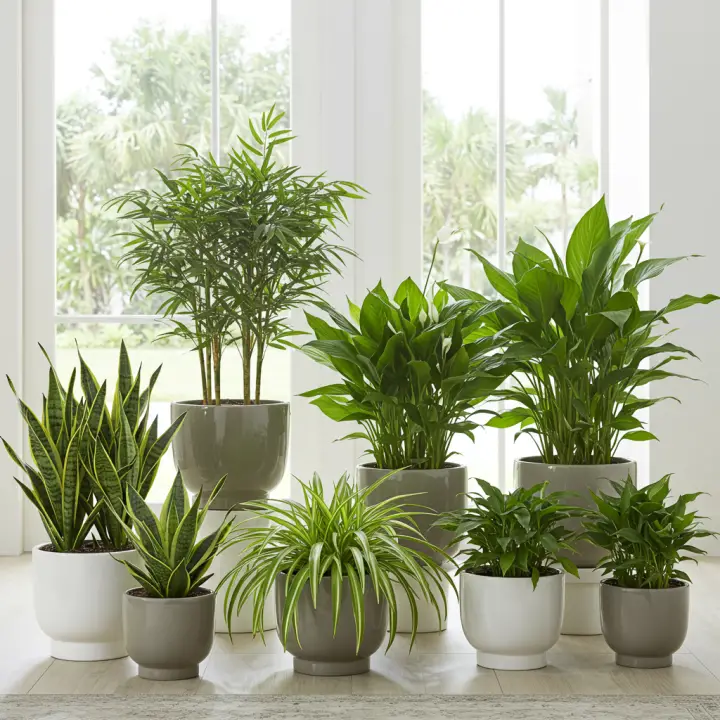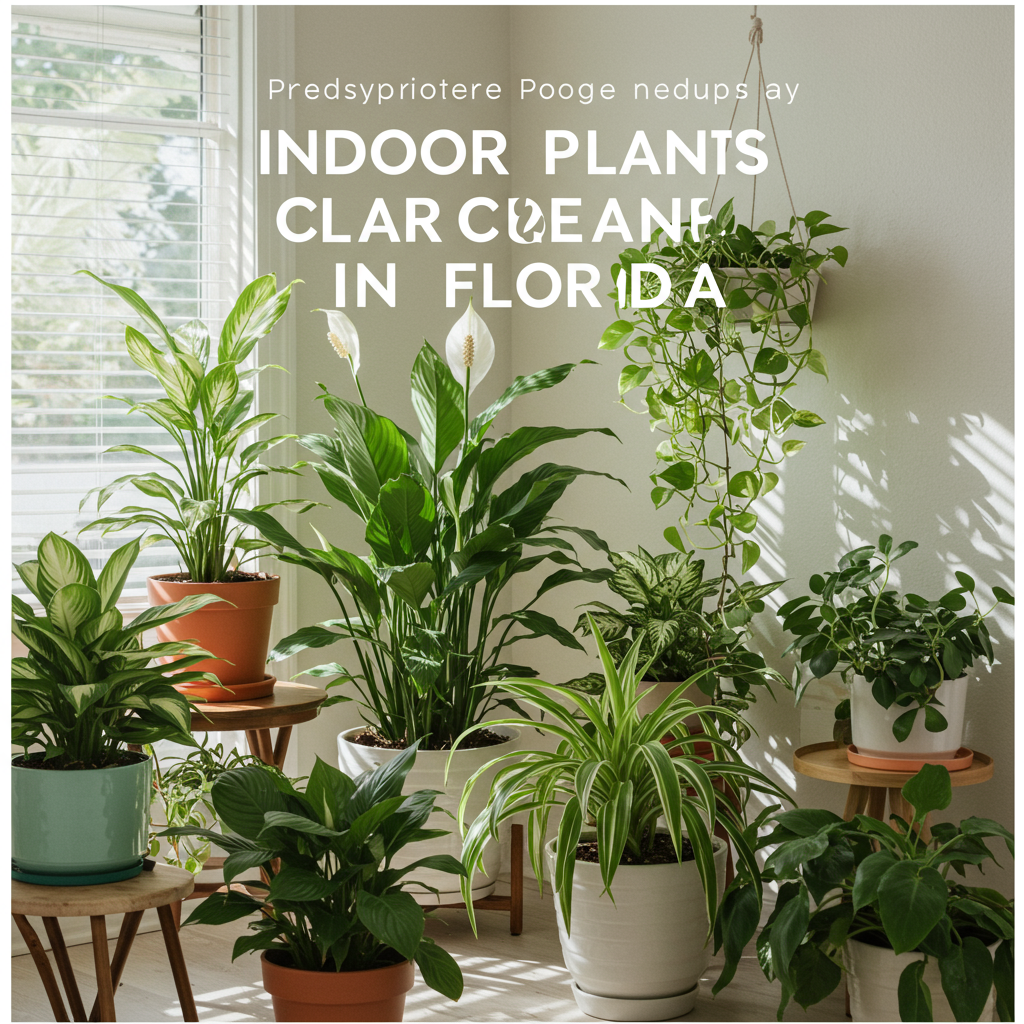Transform your Florida home into a haven of fresh air! This guide reveals why Indoor Plants for Florida’s Clean Air are not just decorative, but essential for combating common indoor pollutants. Discover the best plant varieties, scientific benefits, and practical tips to create a healthier living environment in the Sunshine State.

A Breath of Fresh Air for Your Florida Home
Living in Florida offers incredible sunshine and natural beauty, but it also comes with unique indoor air quality challenges. From high humidity leading to mold spores, to pollen infiltration and off-gassing from common household items, our homes can accumulate a cocktail of airborne pollutants. The good news? Nature provides a simple yet powerful solution: indoor plants. These green allies are more than just pretty decor; they are living air purifiers, working tirelessly to detoxify your home and improve your overall well-being.
Why Florida Needs Cleaner Indoor Air
Florida’s climate and lifestyle contribute to specific indoor air quality concerns that make air-purifying plants particularly valuable.
The Unique Air Challenges in the Sunshine State
Florida’s tropical to subtropical climate means high humidity is a constant companion. While it keeps our skin soft, it also creates an ideal breeding ground for mold and mildew, leading to spores circulating indoors. Beyond humidity, pollen counts can be notoriously high, finding their way inside. Furthermore, many modern homes are built to be airtight for energy efficiency, which, unfortunately, traps indoor pollutants with nowhere to go.
Understanding Indoor Air Pollutants
Our homes are filled with everyday items that off-gas harmful chemicals, known as Volatile Organic Compounds (VOCs). These come from paints, cleaning supplies, furniture, carpets, and even personal care products. Common VOCs include formaldehyde, benzene, trichloroethylene, and xylene. Exposure to these can lead to headaches, dizziness, allergic reactions, and in the long term, more serious health issues. Carbon monoxide and other particulate matter can also compromise indoor air quality, making a silent but significant impact on your health.
How Indoor Plants Become Nature’s Air Purifiers
For centuries, indigenous cultures have known the power of plants. Now, science backs it up, especially regarding air purification.
The Science Behind Plant Air Purification: The NASA Clean Air Study
In the late 1980s, NASA conducted a landmark study to find ways to purify the air in space stations. Their research revealed that common indoor plants are incredibly effective at removing VOCs from the air. This process, known as phytoremediation, involves plants absorbing gases through the tiny pores in their leaves, then transporting them to their roots where microorganisms break them down into nutrients. Essentially, plants “eat” the bad stuff!
Beyond VOCs: Humidity and Oxygen Boost
Beyond chemical filtration, indoor plants for Florida’s clean air offer additional atmospheric benefits. They release oxygen during photosynthesis, subtly increasing oxygen levels in your home. They also transpire moisture, naturally humidifying the air, which can be beneficial in overly dry, air-conditioned environments, potentially easing respiratory discomfort and hydrating skin.
Top Must-Have Indoor Plants for Florida’s Clean Air
Ready to bring the power of plants indoors? Here are some of the best air-purifying plants that thrive in Florida homes, along with brief care tips.
A Hand-Picked Selection for Your Home
Snake Plant (Sansevieria trifasciata): Often called “Mother-in-Law’s Tongue,” this resilient plant removes benzene, formaldehyde, trichloroethylene, and xylene. It’s incredibly low-maintenance, tolerating low light and infrequent watering. Perfect for beginners!
ZZ Plant (Zamioculcas zamiifolia): Another incredibly tough plant that purifies the air. It’s excellent for removing xylene, toluene, and benzene. Known for surviving neglect and very low light levels, making it ideal for busy Floridians.
Pothos (Epipremnum aureum): A versatile trailing plant effective against formaldehyde, benzene, and carbon monoxide. Pothos tolerates various light conditions and is easy to propagate, allowing you to quickly fill your home with air-cleaning greenery.
Peace Lily (Spathiphyllum): Beautiful and graceful, the Peace Lily excels at removing formaldehyde, benzene, trichloroethylene, and ammonia. It also helps reduce mold spores by absorbing moisture from the air. Keep its soil consistently moist and provide medium to low light.
Areca Palm (Dypsis lutescens): This elegant palm is one of the best for removing general indoor air toxins, especially formaldehyde. It also releases a significant amount of moisture into the air, acting as a natural humidifier. Requires bright, indirect light and consistent watering.
Spider Plant (Chlorophytum comosum): Famous for its air-purifying capabilities, especially for formaldehyde and xylene. Spider plants are easy to grow, produce “spiderettes” (baby plants), and are safe for pets. They prefer bright, indirect light.
Boston Fern (Nephrolepis exaltata): A humidity-loving plant that’s fantastic for removing formaldehyde and generally refreshing the air. It thrives in high humidity, making it a perfect fit for Florida, but requires consistent moisture and indirect light.
Maximizing the Air-Purifying Power of Your Indoor Plants
Simply having plants isn’t enough; strategic placement and proper care amplify their benefits.
Strategic Placement and Quantity
For optimal air purification, distribute your plants throughout your home, especially in rooms where you spend the most time, like bedrooms and living areas. A general guideline from the NASA study suggests having at least one plant per 100 square feet. For better results, consider placing more. Varying plant types can also help combat a broader range of pollutants.
Essential Care Tips for Thriving Plants
Light: Understand each plant’s light requirements. Most air purifiers prefer bright, indirect light, which is abundant in Florida homes.
Watering: Don’t overwater! Check the soil moisture before watering. Florida’s humidity might mean less frequent watering than in drier climates.
Humidity: Many of these plants appreciate Florida’s natural humidity, but some might benefit from occasional misting or being grouped to create a mini-microclimate.
Pest Control: Inspect your plants regularly for pests. Early detection and treatment (e.g., with neem oil or insecticidal soap) keep your plants healthy and effective.
Cleaning: Dust your plant leaves regularly. Dust can block pores and hinder their ability to purify the air.
Frequently Asked Questions About Indoor Plants & Clean Air in Florida
Q1: How many plants do I need to clean the air in a room?
While NASA recommended 1 plant per 100 square feet for significant results in a sealed environment, for typical home use, even a few well-placed plants will make a difference. The more, the better, especially for larger rooms or higher pollution levels.
Q2: Are all indoor plants good for air purification?
While all plants produce oxygen, not all are equally effective at removing VOCs. The plants listed above are scientifically proven to be some of the best air purifiers.
Q3: Are these plants safe for pets/children?
Some plants can be toxic if ingested. Always research the specific plant’s toxicity if you have pets or small children. For example, Peace Lilies and Pothos can cause irritation, while Snake Plants are mildly toxic. Spider plants and Boston ferns are generally considered non-toxic.
Q4: Do indoor plants really help with allergies in Florida?
While plants can improve overall air quality by removing pollutants, some individuals might be sensitive to plant pollen or mold that can grow in consistently wet soil. However, many find that the reduction in VOCs outweighs these concerns, and some, like the Boston Fern, actually help by raising humidity. Avoid overly perfumed flowering plants if allergies are a major concern.
Q5: How often should I water indoor plants in Florida’s climate?
Due to Florida’s high humidity, your plants might need less frequent watering compared to those in drier climates. Always check the soil moisture first. Stick a finger about an inch or two into the soil; if it feels dry, it’s time to water.
Conclusion: Embrace a Greener, Cleaner Florida Home
Incorporating indoor plants for Florida’s clean air is one of the simplest and most beautiful ways to enhance your home environment. Beyond their striking aesthetics, these green companions actively work to filter out harmful pollutants, boost oxygen levels, and regulate humidity – all crucial benefits for Floridians. By choosing the right plants and giving them a little love, you’ll be on your way to enjoying a healthier, fresher, and more vibrant living space. Breathe deeper, live better, and let nature purify your Sunshine State home!

